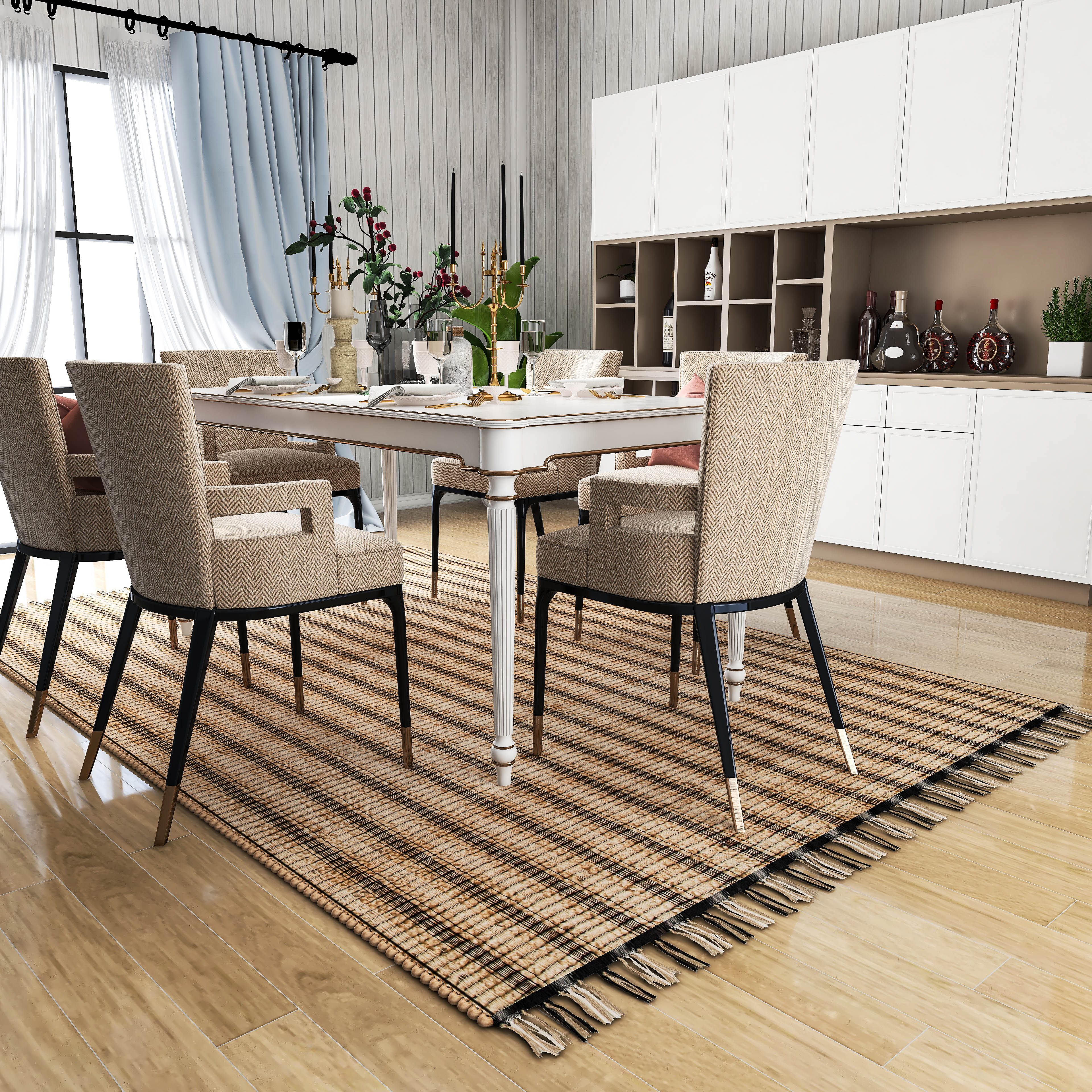
What Is a Jute Rug Made Of? Understanding the Natural Beauty
Jute rugs are made from natural plant fibers, offering sustainability and style. Learn what makes jute rugs unique and why they are a popular choice for eco-conscious homes.
Key Takeaways
- Jute rugs are made from natural plant fibers.
- Jute is biodegradable, making it an eco-friendly choice.
- Jute rugs are durable yet require specific care, especially regarding moisture.
- Ideal for low to medium-traffic areas due to their texture.
What Is Jute, and How Are Jute Rugs Made?
What is a jute rug made of? Jute rugs are crafted from the fibers of the jute plant, a fast-growing, rain-fed crop primarily found in India and Bangladesh. Jute is known as the “golden fiber” due to its silky, golden shine and has been used for centuries to make ropes, sacks, and rugs. The plant's stalks are soaked in water to loosen the fibers, which are then spun into threads and woven into various products, including rugs.
According to the International Jute Study Group, about 85% of the world's jute production occurs in India and Bangladesh. This makes jute a highly sustainable and eco-friendly material, as it requires less water and no chemical fertilizers, unlike cotton.
The Craftsmanship Behind Jute Rugs
Jute rugs are created by weaving or braiding the natural fibers together. Artisans often use traditional looms to handcraft jute rugs, resulting in intricate designs and durable pieces. These rugs are known for their unique texture, which offers a natural, earthy aesthetic that blends well with various interior designs, from modern minimalist to rustic farmhouse.
Jute rugs come in different weaves, such as looped, braided, and flat-woven, allowing consumers to choose based on their preferences for texture and style. Some jute rugs are blended with other materials like cotton or wool to enhance softness.
The Sustainability of Jute Rugs
Jute is one of the most sustainable natural fibers available. It grows quickly—taking just four to six months to reach full maturity—and requires very little water. In fact, jute uses only about 10% of the water needed to grow cotton, making it an environmentally friendly alternative.
The Food and Agriculture Organization (FAO) states that jute crops also help improve soil fertility by returning nutrients back to the earth after harvest.
Moreover, jute rugs are biodegradable, meaning they break down naturally at the end of their lifecycle, unlike synthetic fibers that can sit in landfills for decades. This makes jute rugs an excellent choice for those looking to reduce their carbon footprint.
Why Choose Jute Rugs?
Natural Appeal
One of the main reasons jute rugs are so popular is their natural, rustic beauty. The fibers retain their organic color, ranging from light brown to golden hues. This natural appearance makes jute rugs a great choice for spaces that seek a connection to nature.
Durability
Although jute fibers are strong, they are not as durable as wool or synthetic materials, especially in high-traffic areas. Jute is best used in low to medium-traffic spaces, such as bedrooms, living rooms, or offices. The strength of jute fibers allows them to withstand moderate use while maintaining their texture and aesthetic appeal.
Eco-Friendliness
As mentioned, jute is one of the most eco-friendly materials available. Choosing jute helps reduce the demand for synthetic, non-biodegradable materials like polypropylene, which are often used in rugs but are harmful to the environment.
Jute vs. Other Natural Fibers
When comparing jute to other natural fibers such as sisal or seagrass, jute stands out for its softness. Sisal, for example, is much rougher to the touch and more suitable for high-traffic areas. While both sisal and jute are biodegradable, jute is often the preferred choice for areas where comfort is important, such as living rooms or bedrooms.
Sisal is typically more durable than jute, making it ideal for outdoor rugs or entryways. However, jute’s texture makes it more comfortable for indoor use, particularly in cozy spaces where barefoot traffic is common.
The Limitations of Jute Rugs
While jute rugs offer many benefits, they also come with a few limitations that should be considered before purchasing.
Moisture Sensitivity
Jute fibers are highly absorbent, making the rugs prone to mold and mildew when exposed to excessive moisture. For this reason, it’s best to avoid placing jute rugs in areas like bathrooms, kitchens, or basements, where they may come into contact with water.
Shedding
Jute rugs can shed over time, especially when new. Regular vacuuming without a beater bar will help reduce shedding and keep the rug looking clean and fresh. This shedding is often more pronounced than with other natural fibers like wool.
Durability in High-Traffic Areas
While durable, jute rugs are not the best option for high-traffic areas like hallways or entryways. The fibers can wear down faster under heavy foot traffic, so it’s recommended to use jute in lower-traffic rooms such as bedrooms or home offices.
How to Care for a Jute Rug
Proper maintenance is essential to extend the lifespan of a jute rug.
-
Vacuum Regularly
Regular vacuuming helps to remove dirt and dust particles trapped in the rug’s fibers. Use a vacuum without a rotating brush to prevent fiber damage. -
Avoid Moisture
Jute rugs should be kept dry. If spills occur, blot immediately with a clean cloth. Do not rub, as this can spread the stain and push liquid deeper into the fibers. -
Spot Cleaning
For spot cleaning, use a mild soap mixed with water and apply sparingly. It’s crucial to avoid soaking the rug. After cleaning, blot with a dry towel and let the rug air dry thoroughly to prevent mold or mildew. -
Rotate the Rug
Rotating the rug every few months helps distribute wear and tear more evenly, extending its life.
Jute Rugs and Allergies: Are They Safe?
Jute is a natural fiber and generally safe for people with allergies. Unlike synthetic materials, jute does not off-gas harmful chemicals. However, like other natural fibers, it can attract dust mites if not cleaned regularly. If you have severe allergies, ensure your jute rug is cleaned and maintained regularly to prevent dust buildup.
Where to Use Jute Rugs in Your Home
Jute rugs are perfect for adding a natural, earthy touch to various spaces in your home. Here are some ideal placements:
- Living Room: Jute rugs add warmth and texture to a living room, pairing beautifully with wooden or minimalist furniture.
- Bedroom: The soft texture of jute rugs makes them a comfortable choice for bedrooms.
- Home Office: A jute rug can help create a cozy yet professional atmosphere in a home office, offering a natural aesthetic without overwhelming the space.
Styling Tips for Jute Rugs
Layering
One popular trend is layering jute rugs with other rugs, such as a soft wool rug on top. This adds dimension and softness while maintaining jute’s natural appeal.
Neutral Colors
Since jute rugs typically come in neutral shades, they can easily complement a wide variety of color schemes, from muted tones to more vibrant palettes. For a cohesive look, pair your jute rug with similarly earthy tones in your furniture and décor.
Jute rugs offer a perfect balance between sustainability and natural beauty. They’re ideal for eco-conscious homeowners seeking a durable yet stylish option for low-traffic areas.
Understanding what jute rugs are made of and how to care for them can help you enjoy these timeless pieces for years to come. When treated with care, jute rugs not only enhance the aesthetic of your home but also support environmentally friendly living.
FAQs about Jute Rugs
What is a jute rug made of?
Jute rugs are made from natural plant fibers derived from the stalks of the jute plant, primarily grown in India and Bangladesh.
Are jute rugs soft or scratchy?
Jute rugs are softer than other natural fibers like sisal but may feel a bit rough to some. They work best in areas where barefoot traffic is minimal.
Do jute rugs shed?
Yes, jute rugs can shed, especially when new. Regular vacuuming without a beater bar helps control shedding.
Can jute rugs be used outdoors?
Jute rugs are best suited for indoor use due to their moisture sensitivity. They are not recommended for outdoor areas or damp environments.
How long do jute rugs last?
With proper care, jute rugs can last anywhere from 5 to 10 years, depending on traffic levels and maintenance.
What are the disadvantages of jute carpet?
Sensitive to moisture, sheds, and wears down in high-traffic areas.
Is jute a good rug material?
Yes, it’s eco-friendly, durable, and affordable.
Can I vacuum a jute rug?
Yes, use suction-only without a beater bar.
Are jute rugs soft or scratchy?
They’re soft but can feel slightly coarse.










Leave a comment
This site is protected by hCaptcha and the hCaptcha Privacy Policy and Terms of Service apply.